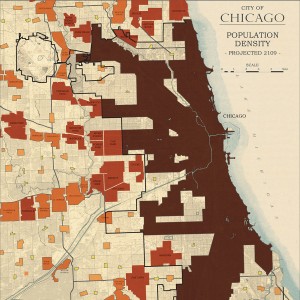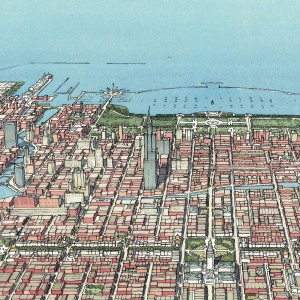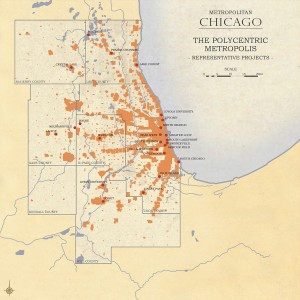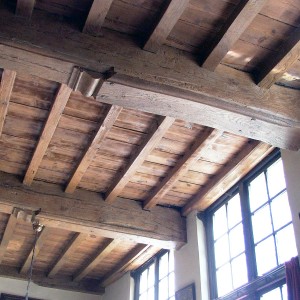Chicago 2109 envisions metropolitan Chicago at the bicentennial of the Plan of Chicago not unlike Daniel Burnham did: as a great urban-agrarian entity imagined as part of a long and large classical humanist urban tradition, within which Chicago becomes one of the great cities of the world by virtue of its beauty, its prosperity, and its promotion of the flourishing of all its inhabitants. But Chicago 2109 also entails a counter-modernist premise: that the broad classical humanist design tradition within which Burnham worked —a tradition which Notre Dame engages and seeks to extend— has a unique capacity to aid in solving many of hyper-modern Chicago’s most demanding practical, aesthetic, and even moral problems; and in doing so perhaps make Chicago instructive to other contemporary hyper-modern cities.
Starting with present-day Chicago, and taking the Burnham Plan as an authoritative reference point, Chicago 2109 proposes a holistic, legible, and humane urbanism that addresses pressing metropolitan Chicago’s problems of land stewardship, regional transportation, water conservation, waste water treatment, tax and zoning law, walkable neighborhood design, durable construction, climate change adaptation, and the symbolic content of urban form. And although Chicago 2109 is cognizant of and takes into account positive aspects of many existing near-term plans and proposals for the future of metropolitan Chicago, it differs from most of these in the following ways:
- Chicago 2109 aspires to reconnect metropolitan Chicago to its natural and agrarian landscape, and locates both Chicago and its landscape (Urbs in Horto) within a context of sacred order;
- Like the Burnham Plan, Chicago 2109 would marry city planning to rather than divorce city planning from architectural and urban design (i.e., would link beauty with both durable wealth and environmental stewardship), and is comprehensive in its approach to the multiple and inter-related planning issues facing metropolitan Chicago; and finally
- Chicago 2109 presumes —based upon current Illinois and Chicago structural fiscal difficulties, and the pending economic consequences of certain fixed demographic events— an unavoidable near-term economic downturn in metropolitan Chicago, followed by the revival it hopes for and depicts. To put this another way: in contrast to Burnham’s grand vision for an energetic 1909 Chicago of abundance, Chicago 2109’s grand vision is for a metropolitan Chicago shaped by an intelligent 21st century stewardship sensibility developed in response to a tired and corrupt early 21st century Chicago of (comparative) scarcity.
Presuming therefore an extended period of 21st century economic and population decline followed by revival (and a 2109 metropolitan population comparable to 20091) —and not presuming environmental or economic apocalypse— Chicago 2109 imagines and depicts long-term environmental, economic and cultural sustainability in Chicago and the seven counties of northeastern Illinois by illustrating good land use, good transportation policy, good building practices, and good urban form. Anticipating (primarily for infrastructure cost and demographic reasons) the decay and abandonment of Chicago’s post-1945 sprawl suburbs, Chicago 2109 envisions some 70% of metropolitan Chicago’s suburban footprint re-purposed as open land for agriculture, commercial forestry, passive waste-water treatment, forest preserves, and prairie. Combined with a damming and re-reversal of the Chicago River and the creation of new active (city) and passive (town and country) water treatment districts, the Chicago 2109 proposals would both recharge regional aquifers and send more of its water back to the Great Lakes Watershed. Establishing sustainable waste and storm water policies is essential to the long term environmental health of metropolitan Chicago, but the de facto foundation for Chicago 2109’s overall water and land use proposals is an integrated transportation system that builds upon and extends metropolitan Chicago’s existing transportation network.
1 Note well however that metropolitan Chicago could easily accommodate up to three times its current (and projected) population in Chicago 2109’s proposed land-use footprint, in buildings not exceeding six stories.
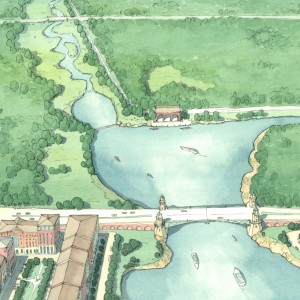
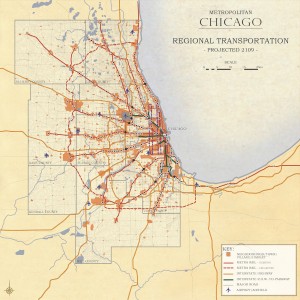
' image-300x300.jpg)
' image-300x300.jpg)
